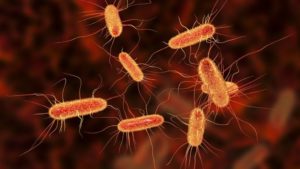by Vinil Samraj Padmini, Global Category Manager, EW Nutrition
Feed safety is essential for animal health and performance – and food safety. Inadequate feed sanitization is still a problem across the globe. It impacts not only the feed industry and animal producers but also puts workers and consumers at risk of being exposed to harmful substances.
Developing a hygiene program for the whole feed chain needs to include proper monitoring of microbial growth, as well as feed processing methods that prevent feed contamination and enable decontamination. This article outlines the importance of feed hygiene and focuses on how organic acids help reduce contamination from “farm to fork”.

Corn is often contaminated with Aspergillus fungi that can produce poisonous mycotoxins
How to achieve feed hygiene
Feed hygiene requires the control of microorganisms throughout the feed production chain. However, producers or retailers can rarely certify or verify feedstuffs’ safety due to the wide range of potential microbial contamination agents and hazards encountered in different feed environments (den Hartog, 2003). The relationship between feed and microorganisms varies, depending on the conditions: feed can transport pathogenic microorganisms and thus directly transmit disease; likewise, microorganisms can also be responsible for feed spoilage and thereby indirectly cause issues (Baer, Miller, and Dilger, 2013).
Since its foundation, the World Organization for Animal Health (OIE) has established standards, guidelines, and recommendations for toxin risk management, including for microorganisms that are transmissible via feed. Recurring outbreaks of Salmonella, Escherichia coli, and other familiar Enterobacteriaceae are a key concern for animal health professionals and the feed industry (Elsayed et al., 2021). However, as factors ranging from climate change to genetic mutations come into play, feed producers are working with moving targets; some of the most significant issues they might face tomorrow are unknown today. There are no easy solutions to these multifactorial problems – but in any case, corrective measures need to include quality control and quality assurance for assessing and managing the pathogenic and microbial risk situation.
To improve animal productivity sustainably, producers regularly experiment with modifying production techniques, innovating feed formulations, but also exploring new ingredients. The inclusion of new ingredients such as animal proteins, oils, and fermented products, among others, heightens the need for strict feed quality monitoring (Truelock et al., 2020). New ingredients come with causative agents of feedborne illnesses, some of which might be unknown (Goodarzi Boroojeni et al., 2016). Therefore, feed and animal producers need to consider how feed changes impact feed safety and include these hazards in their planning and risk assessments.
Better feed hygiene is crucial
For any animal production, feed processing constitutes the most crucial part of feed hygiene management, as it covers all treatments of the feed before ingestion. It is referred to as “hydrothermal processing” due to the use of heat that is required to kill most of the pathogens in raw materials, feedstuffs, and compound feed (Jones, 2011). However, whether or not hydrothermal processing will effectively eliminate a given pathogen depends on its heat resistance. Moreover, factors such as the type of feed components involved and water activity levels also need to be considered to reduce microbial pressure (Doyle and Mazzotta, 2000).
The new generation of feed milling equipment – besides elevating feed costs – can also improve feed quality (Truelock et al., 2020). These technologies tend to enhance feed stability and hygiene by modifying the physicochemical properties of the ingredients. This improves the absorption of nutrients, thereby enabling a higher feed intake efficiency with positive results for animal performance (Abdollahi, Svihus, and Ravindran, 2013). However, while increasing processing time at a given temperature can lead to a better decontamination process, it can also negatively affect some nutrients’ dynamics. This includes enzymes, proteins, minerals, vitamins, fiber and starch, and especially non-starch polysaccharides (Goodarzi Boroojeni et al., 2014).
Organic acids as a solution of feed hygiene risk management
Hence, while significant progress in feed science and feed production technology has already been made, researchers and the industry are still searching for alternative approaches to supporting feed hygiene (Goodarzi Boroojeni et al., 2016). Organic acids are a central research field as they offer promising antimicrobial properties. In combination with feed mill techniques, they already play an essential role in feed preservation (Brul et al., 2002). Despite their efficacy in inhibiting microbial growth, weak organic acids are safe to handle (especially when they are buffered) compared to inorganic acids.
In addition to their preservative effect in feed, it has been shown that organic acids can support gut health. They are not just antimicrobial agents but also acidifiers that display their impact in the stomachs of monogastric animals (Tugnoli et al., 2020).
A combined solution for microbial contamination challenges
To support the feed industry and animal production in light of feed safety challenges in AGP-free production, EW Nutrition focuses research efforts on maximizing the beneficial effect of organic acids. The ACIDOMIX range of products supports the stabilization of the gastrointestinal microflora, inhibiting pathogenic bacterial growth in feed and water. Acidomix is an efficient acidifier specially formulated to have strong antimicrobial effects applicable in feed hygiene programs. Various powder and liquid solutions offer a wide range of benefits:
- Strong antimicrobial effect, supporting the prevention of bacterial infections
- Reducing the incidence of dysbiosis
- Acidifying the feed and digestive tract
- Supporting the improvement of production performance
- Preventing feed re-contamination
- Flexible application
Feedstuffs and compound feed are at risk of contamination and re-contamination throughout the feed production chain: processing, transportation, delivery, storage, and on-farm. Thus, a holistic and integrated approach that includes optimized feed mill processing and customized organic acids is required to improve the feed’s hygiene status. The positive effects are clear: feed producers benefit economically, animal producers reap the effects of improved animal health and performance, and people get to enjoy producing and consuming safe and nutritious food.
References
Abdollahi, M R, B Svihus, and V Ravindran. 2013. “Pelleting of Broiler Diets: An Overview with Emphasis on Pellet Quality and Nutritional Value.” Animal Feed Science and Technology 179 (1–4): 1–23. https://doi.org/10.1016/j.anifeedsci.2012.10.011.
Baer, Arica A, Michael J Miller, and Anna C Dilger. 2013. “Pathogens of Interest to the Pork Industry: A Review of Research on Interventions to Assure Food Safety.” Comprehensive Reviews in Food Science and Food Safety 12 (2): 183–217. https://doi.org/10.1111/1541-4337.12001.
Brul, Stanley, Peter Coote, Suus Oomes, Femke Mensonides, Klaas Hellingwerf, and Frans Klis. 2002. “Physiological Actions of Preservative Agents: Prospective of Use of Modern Microbiological Techniques in Assessing Microbial Behaviour in Food Preservation.” International Journal of Food Microbiology 79 (1–2): 55–64. https://doi.org/10.1016/s0168-1605(02)00179-4.
Doyle, M Ellin, and Alejandro S Mazzotta. 2000. “Review of Studies on the Thermal Resistance of Salmonellae.” Journal of Food Protection 63 (6): 779–95. https://doi.org/10.4315/0362-028x-63.6.779.
Elsayed, Mohamed Sabry Abd Elraheam, Awad A Shehata, Ahmed Mohamed Ammar, Tamer S Allam, and Reda Tarabees. 2021. “The Beneficial Effects of a Multistrain Potential Probiotic, Formic, and Lactic Acids with Different Vaccination Regimens on Broiler Chickens Challenged with Multidrug-Resistant Escherichia Coli and Salmonella.” Saudi Journal of Biological Sciences. https://doi.org/10.1016/j.sjbs.2021.02.017.
Goodarzi Boroojeni, Farshad, Birger Svihus, Heinrich Graf von Reichenbach, and Jürgen Zentek. 2016. “The Effects of Hydrothermal Processing on Feed Hygiene, Nutrient Availability, Intestinal Microbiota and Morphology in Poultry—A Review.” Animal Feed Science and Technology 220: 187–215. https://doi.org/10.1016/j.anifeedsci.2016.07.010.
Den Hartog, Johan den. 2003. “Feed for Food: HACCP in the Animal Feed Industry.” Food Control 14 (2): 95–99. https://doi.org/10.1016/S0956-7135(02)00111-1.
Jones, Frank T. 2011. “A Review of Practical Salmonella Control Measures in Animal Feed.” Journal of Applied Poultry Research 20 (1): 102–13. https://doi.org/10.3382/japr.2010-00281.
Truelock, Courtney N, Mike D Tokach, Charles R Stark, and Chad B Paulk. 2020. “Pelleting and Starch Characteristics of Diets Containing Different Corn Varieties.” Translational Animal Science 4 (4): txaa189. https://doi.org/10.1093/tas/txaa189.
Tugnoli, Benedetta, Giulia Giovagnoni, Andrea Piva, and Ester Grilli. 2020. “From Acidifiers to Intestinal Health Enhancers: How Organic Acids Can Improve Growth Efficiency of Pigs.” Animals 10 (1): 134. https://doi.org/10.3390/ani10010134.
Goodarzi Boroojeni, F., W. Vahjen, A. Mader, F. Knorr, I. Ruhnke, I. Röhe, A. Hafeez, C. Villodre, K. Männer, and J. Zentek. “The Effects of Different Thermal Treatments and Organic Acid Levels in Feed on Microbial Composition and Activity in Gastrointestinal Tract of Broilers.” Poultry Science 93, no. 6 (June 1, 2014): 1440–52. https://doi.org/10.3382/ps.2013-03763.















